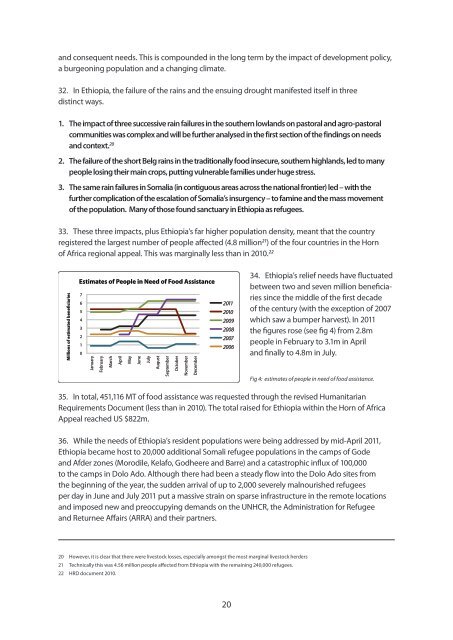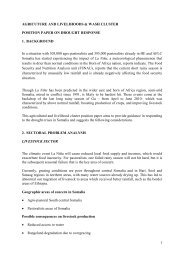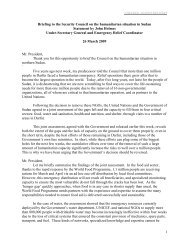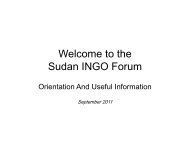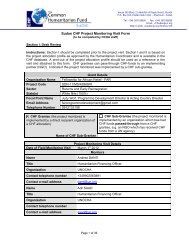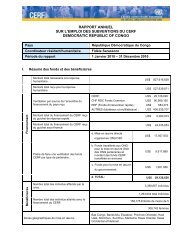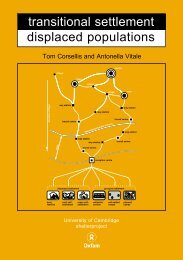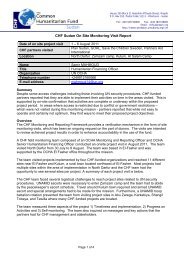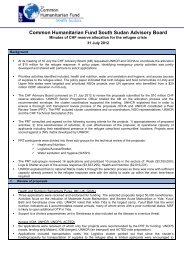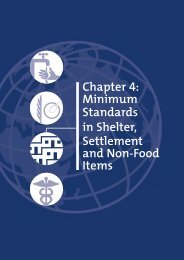Ethiopia - OCHANet
Ethiopia - OCHANet
Ethiopia - OCHANet
Create successful ePaper yourself
Turn your PDF publications into a flip-book with our unique Google optimized e-Paper software.
and consequent needs. This is compounded in the long term by the impact of development policy,<br />
a burgeoning population and a changing climate.<br />
32. In <strong>Ethiopia</strong>, the failure of the rains and the ensuing drought manifested itself in three<br />
distinct ways.<br />
1. The impact of three successive rain failures in the southern lowlands on pastoral and agro-pastoral<br />
communities was complex and will be further analysed in the first section of the findings on needs<br />
and context. 20<br />
2. The failure of the short Belg rains in the traditionally food insecure, southern highlands, led to many<br />
people losing their main crops, putting vulnerable families under huge stress.<br />
3. The same rain failures in Somalia (in contiguous areas across the national frontier) led – with the<br />
further complication of the escalation of Somalia’s insurgency – to famine and the mass movement<br />
of the population. Many of those found sanctuary in <strong>Ethiopia</strong> as refugees.<br />
33. These three impacts, plus <strong>Ethiopia</strong>’s far higher population density, meant that the country<br />
registered the largest number of people affected (4.8 million 21 ) of the four countries in the Horn<br />
of Africa regional appeal. This was marginally less than in 2010. 22<br />
Millions of estimated beneficiaries<br />
Estimates of People in Need of Food Assistance<br />
<br />
<br />
<br />
<br />
<br />
<br />
<br />
<br />
January<br />
February<br />
March<br />
April<br />
May<br />
June<br />
July<br />
August<br />
September<br />
October<br />
November<br />
December<br />
2011<br />
2010<br />
2009<br />
2008<br />
2007<br />
2006<br />
34. <strong>Ethiopia</strong>’s relief needs have fluctuated<br />
between two and seven million beneficiaries<br />
since the middle of the first decade<br />
of the century (with the exception of 2007<br />
which saw a bumper harvest). In 2011<br />
the figures rose (see fig 4) from 2.8m<br />
people in February to 3.1m in April<br />
and finally to 4.8m in July.<br />
Fig 4: estimates of people in need of food assistance.<br />
35. In total, 451,116 MT of food assistance was requested through the revised Humanitarian<br />
Requirements Document (less than in 2010). The total raised for <strong>Ethiopia</strong> within the Horn of Africa<br />
Appeal reached US $822m.<br />
36. While the needs of <strong>Ethiopia</strong>’s resident populations were being addressed by mid-April 2011,<br />
<strong>Ethiopia</strong> became host to 20,000 additional Somali refugee populations in the camps of Gode<br />
and Afder zones (Morodile, Kelafo, Godheere and Barre) and a catastrophic influx of 100,000<br />
to the camps in Dolo Ado. Although there had been a steady flow into the Dolo Ado sites from<br />
the beginning of the year, the sudden arrival of up to 2,000 severely malnourished refugees<br />
per day in June and July 2011 put a massive strain on sparse infrastructure in the remote locations<br />
and imposed new and preoccupying demands on the UNHCR, the Administration for Refugee<br />
and Returnee Affairs (ARRA) and their partners.<br />
20 However, it is clear that there were livestock losses, especially amongst the most marginal livestock herders<br />
21 Technically this was 4.56 million people affected from <strong>Ethiopia</strong> with the remaining 240,000 refugees.<br />
22 HRD document 2010.<br />
20


